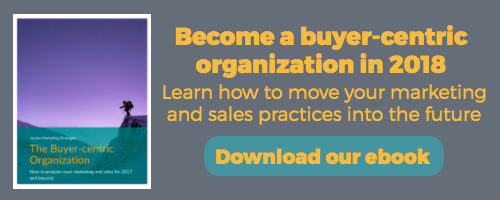The 3 kinds of questions you need to ask your personas


Now more than ever before, buyers control the entire sales process. While salespeople used to initiate relationships with prospects via cold calls or office visits, the first contact is now usually made by prospective buyers looking for more information.
Even as recently as the last decade, salespeople were the gatekeepers of valuable information about their product, including specifications and pricing. But now, most prospects have access to all relevant information well before they talk to a salesperson.
For marketers that are trying to partner effectively with their sales teams and create value for their businesses, it’s important to take these changes into consideration. Effective marketing isn’t about trying share your company’s message with as many people as possible. Instead, savvy marketers will try to reach a highly targeted set of people in order to help drive sales.
But who is this highly targeted set of people? How do you find them online? How do you know what will provide value for them and resonate with them? The best way to answer all of those questions for your company is to do some persona research.
If you’re unfamiliar with the concept, a persona is a semi-fictional profile of your ideal buyer that guides your marketing efforts. Before starting any new marketing activities, it’s wise to spend some time interviewing at least 3-5 people (customers or people who closely align with your ideal customer) to learn help you create this profile.
What kinds of information are you trying to gather from these interviews? Start with...
Demographic information
Asking demographic questions is pretty straightforward, and the questions will likely be similar for most industries. They should help you determine information like:
- Job title
- Education level
- What they studied in college and where they studied (if applicable)
- Salary range (note: This is a sensitive question to ask. Instead of asking, it may be preferable to look up average salaries on sites like Glassdoor based on the job title just to get a basic idea.)
- Age
- Marital and family status
This kind of information forms the skeleton of your persona, and it can give you a good starting point to create tailored content. You can get answers to some of these questions before you ever interview a single prospect or customer by looking at LinkedIn. Remember, the persona you create is semi-fictional, so you’re looking for broad strokes and general patterns here.
Imagine you work for a software company that provides a scheduling solution for medical offices. Here’s a sample of a persona for your company based on purely demographic information:
.png?width=598&height=199&name=sally-persona-1%20(1).png)
This information is valuable, but it’s a little bland. That’s why it’s important to add color to your personas by asking about…
Personal preferences
Asking this kind of question provides useful insights that will help you understand your personas as human beings a little better. These questions should tell you things like:
- What TV shows they like and how they consume them (Do they have cable, or are they “cordcutters” who use services like Netflix and Hulu to watch TV?)
- What movies they like, and how they consume them (Do they prefer to go to the theater? Stay at home and watch on Netflix?)
- What publications they regularly read and how they read them (Do they get physical copies of magazines and newspapers, or do they prefer digital subscriptions?)
- What social media networks they use and for what
While it may sound hokey to ask for information about personal taste in pop culture in your persona interviews, it’s become clear to many successful brands that understanding those preferences in your personas is key. It allows you to laser focus and find the exact message that will resonate with your audience.
Remember, your buyers are people, and their personal and professional lives are becoming increasingly merged. That means your message is competing for their attention against many other brands— both professional and consumer-focused. The way to differentiate yourself lies in creating content that feels fresh, personal, and relevant to each person that interacts with your brand.
Here’s a continuation of Sally’s persona above including a little bit of data about her personal taste:

Knowing this additional information about Sally’s consumption of pop culture and social media gives you a leg up on your competitors. It allows you to use references in your content that are familiar to her, which can make her feel more comfortable with your company.
Understanding a little bit about your personas’ personal lives will allow you to publish useful, delightful content when and where it’s most likely to provide value to the people who match your description. But there’s one more crucial category of information that’s important to gather when you’re researching your personas, and that’s…
The buyer’s journey
The phrase “buyer’s journey” describes the path that a buyer takes before purchasing a product or service. To find out about the typical buyer’s journey for your personas, you’ll want to ask the people you interview about:
- Their first contact with your company
- What pieces of your content were most/least valuable to them
- What problems they were initially looking to solve
- What other competitors’ solutions they considered
- What factors they used to help make a decision
- Who the other decision makers are in her organization (if any)
- Whether or not they chose to use go forward with buying your goods or services in the end
This sort of information is a goldmine for marketers. Knowing who your audience views as your closest competitors, and what they see as the key differences between you, allows you to tailor your messaging and highlight the things that will make you stand apart. Understanding the individual pain points that lead your target audience to look for a solution helps you to build a story about what you do and how you can help.
Here’s Sally’s persona, amended to include some of those details:

Do you see how useful this information could be to help you attract more customers like Sally? Knowing what it was that encouraged your customers to engage with your brand lets you know which parts of your sales and marketing processes to continue with, and which ones may not need as much focus in the future.
If you’re just starting an inbound marketing campaign, or if it’s been some time since you interviewed and updated your personas, it’s a good idea to interview some customers (or even former leads who chose to work with a competitor). This practice will provide valuable insights that will allow you to refine your sales and marketing processes for maximum effectiveness, help you continue to offer your customers a delightful experience.
To learn about some other practices that can help your inbound marketing and sales processes provide a delightful experience for your customers, read our ebook, The Customer-Centric Organization. Download your copy below:






